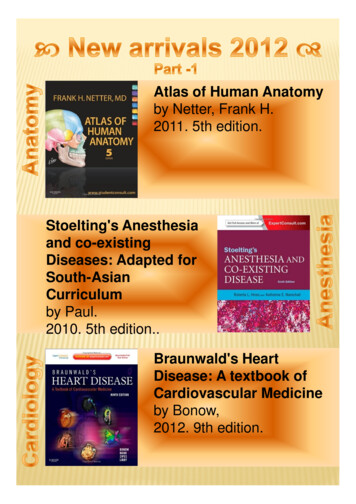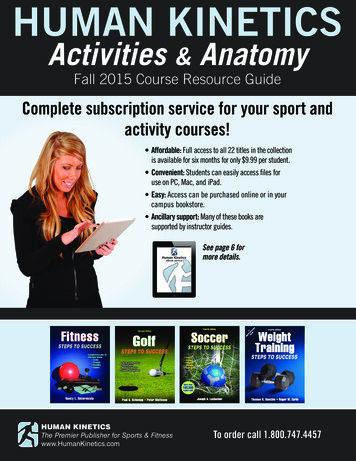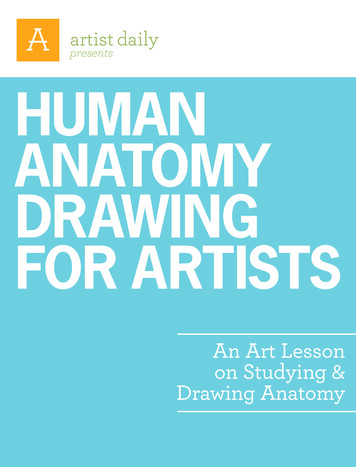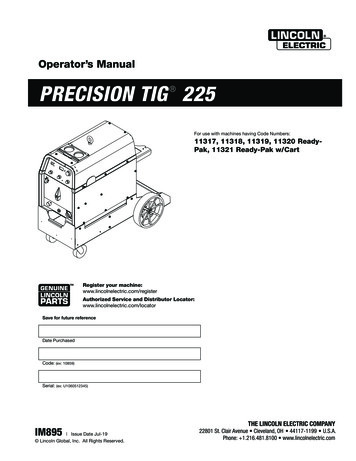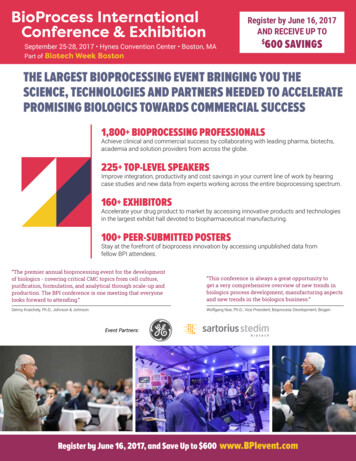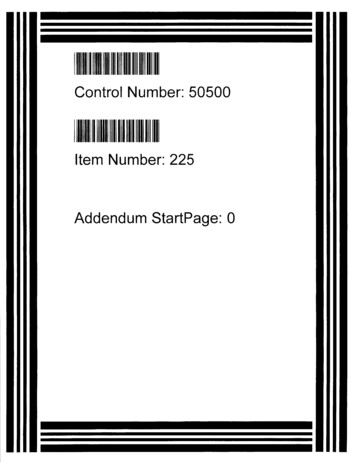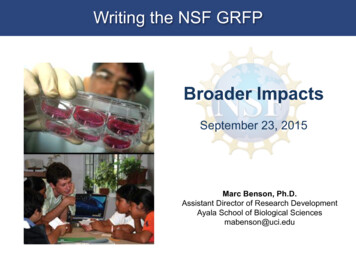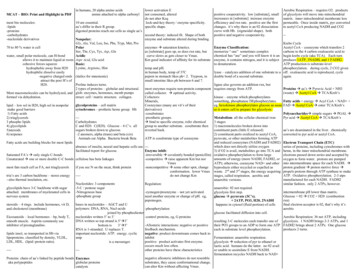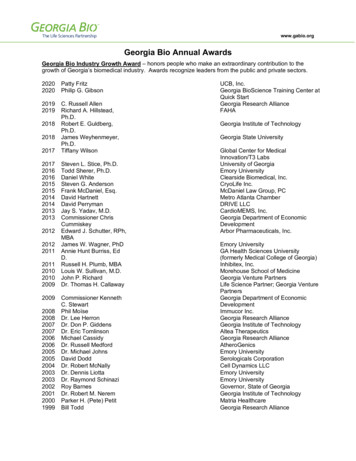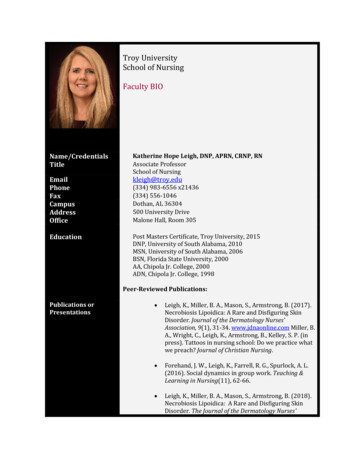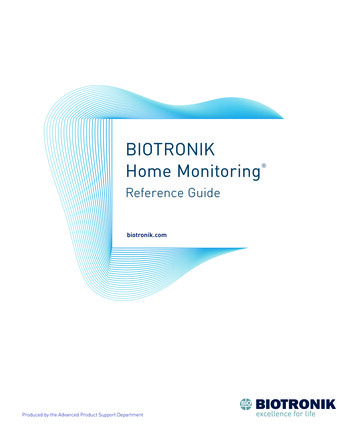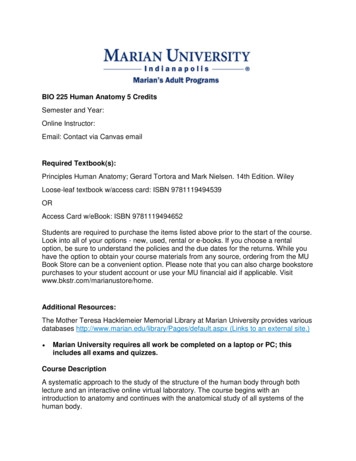
Transcription
BIO 225 Human Anatomy 5 CreditsSemester and Year:Online Instructor:Email: Contact via Canvas emailRequired Textbook(s):Principles Human Anatomy; Gerard Tortora and Mark Nielsen. 14th Edition. WileyLoose-leaf textbook w/access card: ISBN 9781119494539ORAccess Card w/eBook: ISBN 9781119494652Students are required to purchase the items listed above prior to the start of the course.Look into all of your options - new, used, rental or e-books. If you choose a rentaloption, be sure to understand the policies and the due dates for the returns. While youhave the option to obtain your course materials from any source, ordering from the MUBook Store can be a convenient option. Please note that you can also charge bookstorepurchases to your student account or use your MU financial aid if applicable. Visitwww.bkstr.com/marianustore/home.Additional Resources:The Mother Teresa Hacklemeier Memorial Library at Marian University provides variousdatabases http://www.marian.edu/library/Pages/default.aspx (Links to an external site.) Marian University requires all work be completed on a laptop or PC; thisincludes all exams and quizzes.Course DescriptionA systematic approach to the study of the structure of the human body through bothlecture and an interactive online virtual laboratory. The course begins with anintroduction to anatomy and continues with the anatomical study of all systems of thehuman body.
Upon successful completion of this course, students will be able to:Student Learning ObjectivesCourse Learning ObjectivesDescribe the biochemical construct of the cellmembraneAnalyze the relationship between cells, theirorganelles, and their functionIdentify (by light micrograph or by description) specificcellular types or cellular organelles and their functionsCategorize different tissue types and their intimaterelationshipsRelate the structure of different tissue types to thehuman system in which they are locatedIdentify tissues by description or light micrographCompare the anatomical and functionalsimilarities/differences of the integumentary layersIdentify bones and/or their markings on anatomicalmodelsClassify articulations based on their anatomicalstructureIdentify the microscopic components of skeletalmuscle cellsIdentify the gross anatomical components of skeletalmuscle cellsRecall function(s) of the major muscles of the bodyIdentify diagrammatically or on anatomical models themajor muscles of the human bodyRecall the structural organization and embryology ofthe nervous systemSummarize the structural and functional types ofneurons and neuroglia cellsIdentify the components of the spinal cord bydescription or on anatomical modelsCompare the anatomical and functional similarities ordifferences of the components of the brain stemSummarize the functional characteristics of theforebrainMethods of AssessmentAP 1, Chapter Assessment 1AP 2, Chapter Assessment 2AP 2, Chapter Assessment 2AP 3, Chapter Assessment 3Discussion: Module 1, AP 3, ChapterAssessment 3AP 3, Chapter Assessment 3AP 5, Chapter Assessment 5, AP 27,Chapter Assessment 27AP 6-8, Chapter Assessments 6-8AP 9, Chapter Assessment 9Abstract 1, AP 10, ChapterAssessment 10Abstract 1, AP 10, ChapterAssessment 10Discussion: Module 3, AP 11, ChapterAssessment 11AP 11, Chapter Assessment 11AP 4, AP 19-20 Chapter Assessment 4& 19-20Discussion; Module 5, AP 16, ChapterAssessment 16AP 17, Chapter Assessment 17Abstract 3, AP 18, ChapterAssessment 18Abstract 3, AP 18, ChapterAssessment 18
Identify the components of the eye and ear bydescription or on anatomical modelsSummarize the functional characteristics of cranialnerves and spinal nervesRecall the microscopic and functional characteristics ofblood cellsIdentify the components of blood vessels and theheart by description or on anatomical modelsIdentify the components of the respiratory anddigestive systems by description or on anatomicalmodelsIdentify the components of the endocrine, urinary, andreproductive systems by description or on anatomicalmodelsAP 21, Chapter Assessment 21Abstract 3, AP 17 & 18, ChapterAssessments 17 & 18Abstract 2, AP 12, ChapterAssessments 12AP 13 & 14, Chapter Assessments 13& 14AP 23 & 24, Chapter Assessments 23& 24Discussion: Module 7, Abstract 4, AP22 & 25-26, Chapter Assessments 22& 25-26Teaching StrategiesLecture:The lecture portion of the course is self-directed through posted readings,presentations, and experiential learning activities in each module. Each module alsocontains three graded components; assessment and either a discussion or an abstract.There will be one cumulative final exam at the end of the course.Lab:The lab portion of the course is facilitated through activities linked to the Wiley Plustextbook. Students will participate in dynamic study modules and the adaptive practicehomework assignments (graded) which relate to the content found in each chapter toprepare themselves for each quiz.Assignments & Assessment Methods:AssignmentValueFrequencyAssignment Zero5OnceDiscussions25x4Abstracts25x4Adaptive Practice15x 27Assessments20x 27Final100Once
Total points1245Methods of EvaluationReadings, presentations, and experiential learning activities cover the relevant chaptersfrom the textbook and the photographic atlas. Learning activities are comprised of matching, labeling, and other brain games.Links to the adaptive practices and their due dates are located on the last content pageof each module for every chapter. Each adaptive practice is worth a total of 15 points.Points for each adaptive practice will be allotted according to the percentage ofproficiency of the assignment. 81% - 100% 15/15 points , 61% - 80% 11.25/15points, 41%-60% 7.5/15 points, 21%-40% 3.75/15 points, 0%-20% 0/15 points.Up to the due date, the adaptive practices may be completed as many times as thestudents desires to improved the score. Once the due date passes scores will besent to the grade book.Links to the discussion questions and their due dates are located on chapters 1, 11, 18& 24 . Initial posts must be 300 words in length. Replies to 2 classmates must be 150words in length each. Initial posts must be 300 words in length. Replies to 2 classmates must be 150words in length each.Initial posts are due by 11:59 p.m. EST (2) days prior to the due date.Replies to 2 classmates must be submitted by 11:59 p.m. EST on the due date.Your instructor will review all of the posts and replies and make comments thefollowing Sunday.Links to the abstract submission pages and their due dates are located on the contentpage of Modules 2, 4, 6, & 8. Your task is to select a scholarly article related to a topicin Anatomy covered in the corresponding module and write a 1 page abstract with thefollowing guidelines: Abstracts must be single spaced, in 12-point, Times New Roman font.Include a work cited page.Abstracts must include the following sections: objectives, methods, results, andconclusions.Abstracts must be submitted by 11:59 p.m. EST on the day they are due.Links to the assessments and their due dates are located on the last content page ofeach module. Each assessment has multiple-choice questions for a total of 20 points.
Once you start, you will have 25 minutes to complete each quiz.If you start a quiz with less than 25 minutes remaining before 11:59 p.m. on the dayit is due , it will timeout at 11:59 p.m. EST and you will only earn credit for thequestions that have been completed.The final exam is located in the Modules and Assignments sections of this course. The final exam consists of 50 questions comprised of multiple choice questions andtrue false questions selected randomly from pools, valued at 2 points per question,for a total of 100 points.You will have a 24-hour window to take the final exam.The 24-hour window starts at 12:01 a.m. EST and ends at 11:59 p.m. EST the daythe final exam is scheduled.Once you start, you will have 90 minutes to complete the final exam.If you start the final exam with less than 90 minutes remaining in the 24-hourwindow, it will timeout at 11:59 p.m. EST and you will only earn credit for thequestions that have been completed.Dynamic study modules and optional homework assignments cover the applicablechapters from the textbook and the photographic atlas. These items are not graded, but participation is HIGHLY ENCOURAGED.Grading ScaleCourse Policies:Letter GradePercentageA95 - 100A-90 - 95B 87 - 90B83 - 87B-80 - 83C 77 - 80C73 - 77C-70 - 73D 66 - 70D60 - 66F 60
Late Policy & Due Date Extensions: Acceptance of work submitted past the due dateor requests of due date extensions, including exams, may be considered in the event ofunforeseen, documented hardships, such as medical emergencies, documentabletechnical issues, death of a loved one, etc. However, simply forgetting, time zonedifferences, going on vacation, or not preforming a well as intended are not acceptableexcuses.Exam Retakes: Exams retakes are different than requesting and being granted anextension on an exam. There are no exam retakes allowed in this course. Once youopen an exam, you’re stating that you have prepared adequately for the exam andyou’re accepting the results of the exam.Extra Credit: There is no extra credit in this course.Plagiarism Statement: Plagiarism is using the words or ideas of another as your ownwithout giving credit to the source author. This also includes taking a paper found onlineand submitting it as one’s own paper and/or cutting and pasting from a website andsubmitting it as your work product.Plagiarism is defined in detail in the Code of Student Rights and Responsibilities underSection 8: Academic Conduct Procedures, as well as an extended description ofacademic ies.pdf?sfvrsn 18 (Links to an external site.)The following are some helpful websites for understanding plagiarism, documentationand citation: Marian University’s library: https://www.marian.edu/current-students/library (Links toan external site.)Plagiarism.org: https://plagiarism.org/ (Links to an external site.)Purdue OWL: https://owl.purdue.edu/ (Links to an external site.)Student HandbookPlease refer to the MAP Student Resources and Student Support Resources modulesfor information regarding academic and school of policies including Services forStudents with Disabilities.**Any changes to this syllabus will be communicated to the student.
Principles Human Anatomy; Gerard Tortora and Mark Nielsen. 14th Edition. Wiley Loose-leaf textbook w/access card: ISBN 9781119494539 OR Access Card w/eBook: ISBN 9781119494652 Students are required to purchase the items listed above prior to the start of the course. Look into all of your options - new, used, rental or e-books. If you choose a rental option, be sure to understand the policies .
